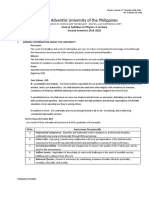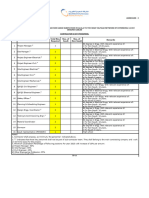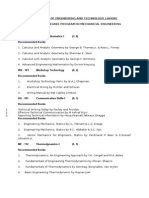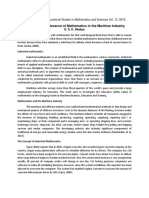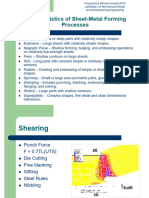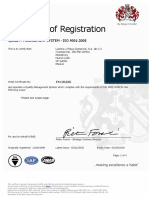LAB MANUAL
Database Management System
CIC-256
Maharaja Agrasen Institute of Technology, PSP
area, Sector- 22, Rohini, New Delhi – 110085
Affiliated to Guru Gobind Singh Indraprastha University
New Delhi
MAIT/CSE
� MAHARAJA AGRASEN INSTITUTE OF TECHNOLOGY
VISION
“To attain global excellence through education, innovation, research, and work ethics
with the commitment to serve humanity.”
MISSION
The Institute shall endeavour to incorporate the following basic missions in the
teaching methodology:
M1. To promote diversification by adopting advancement in science, technology, management, and
allied discipline through continuous learning
M2. To foster moral values in students and equip them for developing sustainable solutions to serve
both national and global needs in society and industry.
M3. To digitize educational resources and process for enhanced teaching and effective learning.
M4. To cultivate an environment supporting incubation, product development, technology transfer,
capacity building and entrepreneurship.
M5. To encourage faculty-student networking with alumni, industry, institutions, and other
stakeholders for collective engagement.
i
� MAHARAJA AGRASEN INSTITUTE OF TECHNOLOGY
COMPUTER SCIENCE & ENGINEERING DEPARTMENT
VISION
“To attain global excellence through education, innovation, research, and work ethics in the field of
Computer Science and engineering with the commitment to serve humanity.”
MISSION
M1: To lead in the advancement of computer science and engineering through internationally
recognized research and education.
M2: To prepare students for full and ethical participation in a diverse society and encourage
lifelong learning.
M3: To foster development of problem solving and communication skills as an integral
component of the profession.
M4: To impart knowledge, skills and cultivate an environment supporting incubation, product
development, technology transfer, capacity building and entrepreneurship in the field of
computer science and engineering.
M5: To encourage faculty, student’s networking with alumni, industry, institutions, and other
stakeholders for collective engagement.
ii
�Program Outcomes (POs)
Engineering Graduates will be able to:
1.Engineering knowledge: Apply the knowledge of mathematics, science, engineering fundamentals,
and an engineering specialization to the solution of complex engineering problems.
2.Problem analysis: Identify, formulate, review research literature, and analyze complex engineering
problems reaching substantiated conclusions using first principles of mathematics, natural sciences, and
engineering sciences.
3.Design/development of solutions: Design solutions for complex engineering problems and design
system components or processes that meet the specified needs with appropriate consideration for the
public health and safety, and the cultural, societal, and environmental considerations.
4.Conduct investigations of complex problems: Use research-based knowledge and research methods
including design of experiments, analysis and interpretation of data, and synthesis of the information to
provide valid conclusions.
5.Modern tool usage: Create, select, and apply appropriate techniques, resources, and modern
engineering and IT tools including prediction and modeling to complex engineering activities with an
understanding of the limitations.
6.The engineer and society: Apply reasoning informed by the contextual knowledge to assess societal,
health, safety, legal and cultural issues and the consequent responsibilities relevant to the professional
engineering practice.
7.Environment and sustainability: Understand the impact of the professional engineering solutions in
societal and environmental contexts, and demonstrate the knowledge of, and need for sustainable
development.
8.Ethics: Apply ethical principles and commit to professional ethics and responsibilities and norms of
the engineering practice.
9.Individual and team work: Function effectively as an individual, and as a member or leader
indiverse teams, and in multidisciplinary settings.
10.Communication: Communicate effectively on complex engineering activities with the engineering
community and with society at large, such as, being able to comprehend and write effective reports and
design documentation, make effective presentations, and give and receive clear instructions.
11.Project management and finance: Demonstrate knowledge and understanding of the engineering
and management principles and apply these to one’s own work, as a member and leader in a team, to
manage projects and in multidisciplinary environments.
12.Life-long learning: Recognize the need for, and have the preparation and ability to engage in
independent and life-long learning in the broadest context of technological change
iii
�Program Specific Outcome (PSO)
PSO1: Able to explore and apply emerging technologies in computer science and engineering such as
Artificial Intelligence, Machine Learning, Data Science, etc.
PSO2: Able to independently and collaboratively design, develop and evaluate innovative solutions to
existing problems, addressing the needs of industry and society.
PSO3: Able to pursue advanced studies, conduct research and development, and cultivate
entrepreneurship skills in the modern computing environment.
Program Educational Objectives (PEO)
PEO1: Graduates will work with the top institutions and researchers, dedicating themselves to lifelong
learning and social responsibility. (M1, M2)
PEO2: Graduates will exhibit outstanding communication skills and the capacity to collaborate
effectively within diverse teams. (M3)
PEO3: Graduates cultivating skills in computer science and engineering contribute to driving
innovation,
entrepreneurship, and economic growth. (M4)
PEO4: Graduates network with stakeholders to contribute to the growth of the department. (M5)
iv
� INDEX OF THE CONTENTS
Page No:
1. Introduction to the lab……………………………………………………………………………… 1
2. Lab Requirements (details of H/W & S/W to be used)………………………………………….. 2
3. List of Experiments as per GGSIPU…………………………………………………………….. 3
4. List of experiments beyond the syllabus…………………………………………………………4
5. Format of the lab record to be prepared by the students………………………………………..5
6. Marking scheme for the Practical Exam………………………………………………………….7
7. Instructions for each Lab Experiment……………………………………………………….…..15
v
� 1. Introduction to the Lab
Course Objectives:
1. To introduce basic concepts, architecture and characteristics of database systems
2. To introduce relational model concepts and PL/SQL programming
3. To introduce relational database design and Normal forms based on functional dependencies
4. To introduce concepts of object-oriented & distributed databases
Revised Course Outcomes:
CO 1 Ability to understand the basics of database systems
CO 2 Ability to use SQL as DDL, DCL and DML
CO 3 Ability to understand and apply relational model concepts, SQL functions, advanced query
operations, and transaction control for efficient database management.
CO 4 Ability to understand and apply relational database design principles, normalization, transaction
management, concurrency control, recovery techniques, and PL/SQL programming for efficient
and reliable database systems.
Course Outcomes (CO) to Programme Outcomes (PO) mapping:
PO1 PO2 PO3 PO4 PO5 PO6 PO7 PO8 PO9 PO10 PO11 PO12
CO1 3 3 3 2 2 1 1 1 1 2 1 2
CO2 3 3 3 2 2 1 1 1 1 2 1 2
CO3 3 3 3 2 3 2 1 2 1 2 1 2
CO4 3 3 3 2 3 1 1 1 2 2 1 2
Course Outcomes (CO) to Program Specific Outcome Mapping:
PSO1 PSO2 PSO3
CO1 2 2 1
CO2 2 2 1
CO3 3 3 2
CO4 3 3 3
1
�2. LAB REQUIREMENTS
Hardware Detail
Intel i3 Processor/4 GB RAM/1TB HDD/MB/LAN Card/
Key Board/ Mouse/15” Color Monitor/ UPS 24 Nos
LaserJet Printer 1 No
Software Detail
Operating System: F e dora, Linux
Software: Maria DB
2
�3. LIST OF EXPERIMENTS (As prescribed by G.G.S.I.P.U)
1. Experiments based on DDL commands – CREATE, ALTER, DROP and TRUNCATE. (CO1, CO2)
2. Apply the integrity constraints like Primary Key, Foreign key, Check, NOT NULL, etc. to the tables.
(CO3)
3. Experiments based on basic DML commands – SELECT, INSERT, UPDATE and DELETE. (CO2)
4. Write the queries for implementing Built-in functions, GROUP BY, HAVING and ORDER BY. (CO3)
5. Write the queries to implement the joins. (CO3)
6. Write the queries to implement the subqueries. (CO3)
7. Write the queries to implement the set operations. (CO3)
8. Write the queries to create the views and queries based on views. (CO4)
9. Demonstrate the concept of Control Structures. (CO4)
10. Demonstrate the concept of Exception Handling. (CO4)
11. Demonstrate the concept of Functions and Procedures. (CO4)
12. Demonstrate the concept of Triggers. (CO4)
3
�4. LIST OF EXPERIMENTS (beyond syllabus)
1. The Institute offers multiple B. Tech Courses. Students can take admission in any Course offered by the
Institute. Multiple subjects are taught in each branch. The institute has a Director and Hod of each B.
Tech Course. The HoD of another branch may be given additional responsibility to take charge of one
more department for a limited period in the absence of Hod of that branch. Faculties recruited in each B.
Tech Course can teach only a single same subject to students of different B.Tech Courses. For each
subject, there is a faculty coordinator responsible for coordinating all the faculties teaching the same
subject. A batch of 20 students is assigned a faculty mentor. The mentor takes counsellor meetings twice
a month.
Data to be recorded in the database include:
Student – enrollment no, name, date of birth, address, contact no, email – id, qualifying exam
rank, Course
Faculty – Faculty name, contact no, email id, course
Parents data – Parents name, contact no, email id, Profession
Draw the ER diagram (Conceptual design) of the given problem statement. (CO1)
2. To demonstrate a connection to a MariaDB database using the following languages: C, Java and Python
4
�5. FORMAT OF THE LAB RECORD TO BE PREPARED BY THE STUDENTS
The front page of the lab record prepared by the students should have a cover page as displayed below.
NAME OF THE LAB
Paper Code
Font should be (Size 20”, italics bold, Times New Roman)
Faculty name Student name
Roll
No.:
Semester:
Font should be (12”, Times Roman)
Maharaja Agrasen Institute of Technology, PSP Area,
Sector – 22, Rohini, New Delhi – 110085
5
�Font should be (18”, Times Roman)
6
� 9
8
7
6
5
4
3
2
1
10
S.No
Experiment
Student Enrollment No:
2
Is able to identify and define the
R1
objective of the given problem?
2
Is proposed design /procedure
R2
/algorithm solves the problem?
2
Has the understanding of the
R3
tool/programming language to
Marks Marks Marks
implement the proposed solution?
2
Are the result(s) verified using
R4
sufficient test data to support the
conclusions?
2
R5
Individuality of submission?
Marks Marks
(10)
Total
Marks
Student Name:
Remarks
Database Management System Lab (CIC - 256) Lab Assessment Sheet
Faculty
Signature
7
�6. MARKING SCHEME FOR THE PRACTICAL EXAMS
There will be two practical exams in each semester.
i. Internal Practical Exam
ii. External Practical Exam
INTERNAL PRACTICAL EXAM
It is taken by the respective faculty of the batch.
MARKING SCHEME FOR THIS EXAM IS:
Total Marks: 40
Division of 10 marks per practical is as follows:
10 Marks POs and PSOs Covered
Rubrics 0
1 Marks 2 Marks PO PSO
Marks
Is able to identify and
PSO1,
R1 define the objective of the No Partially Completely PO1, PO2
PSO2
given problem?
Is proposed
PO1, PO2, PSO1,
R2 design/procedure/algorithm No Partially Completely
PO3 PSO2
solves the problem?
Has the understanding of
the tool/programming PO1, PO3, PSO1,
R3 No Partially Completely
language to implement the PO5 PSO2
proposed solution?
Are the result(s) verified
PO2, PO4,
R4 using sufficient test data to No Partially Completely PSO2
PO5
support the conclusions?
Individuality of PSO1,
R5 No Partially Completely PO8, PO12
submission? PSO3
8
�Each experiment will be evaluated out of 10 marks. At the end of the semester, an average of 8 best
performed practical’s will be considered as marks out of 40.
EXTERNAL PRACTICAL EXAM
It is taken by the concerned lecturer of the batch and by an external examiner. In this exam, the
student needs to perform the experiment allotted at the time of the examination; a sheet will be
given to the student in which some details asked by the examiner need to be written, and at the
last, viva will be taken by the external examiner.
MARKING SCHEME FOR THIS EXAM IS:
Total Marks: 60
Division of 60 marks is as follows
1. Sheet filled by the student: 20
2. Viva Voice: 15
3. Experiment performance: 15
4. File submitted: 10
NOTE:
Internal marks + External marks = Total marks given to the students
(40 marks) (60 marks) (100 marks)
Experiments given to perform can be from any section of the lab.
9
�10





























































